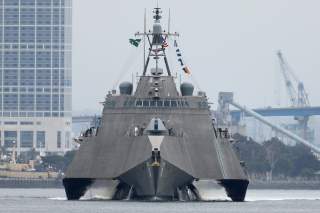Can the Littoral Combat Ship Kill Torpedos?
It's not as crazy as it sounds.
Key Point: Without help from larger ships, the Littoral Combat Ship needs to protect itself.
The Navy is advancing plans to arm is Littoral Combat Ship with an emerging ship defense soft-kill countermeasure able to identify, track and destroy incoming enemy torpedo fire, Navy officials said.
The service plans to outfit its entire LCS fleet with the AN/SLQ-61 Lightweight Tow Torpedo Defense Mission Module (TDMM) as a way to fortify the ship’s ability to succeed in both shallow water and open or “blue” water warfare, Navy officials told Warrior Maven.
The new TDMM completed two days of at-sea testing several months ago in order to prepare for operational service on LCS ships.
(This article first appeared in October 2018.)
“This test was highly successful, and this critical torpedo defense for the LCS is ready for integration,” Capt. Theodore Zobel, LCS Mission Modules program manager, said in a written statement earlier this year.
A technology uses an underwater acoustic projector, attached to a cable dropped from the ship’s stern to identify acoustic homing and wire-guided enemy torpedoes, service officials described.
"The torpedo defense capability the TDMM provides is envisioned for eventual deployment on all LCS ships, and potentially other small combatants," a Navy statement said.
Offered as a lighter-weight alternative to the currently-operational AN/SLQ-25 “Nixie,” the new TDMM is specifically engineered for smaller warships, such as the LCS, Navy statements said.
The addition of this combat technology to the LCS is consistent with the Navy’s evolving strategy for the ship, which seeks to broaden its mission scope to incorporate a wider range of surface combat possibilities.
While the ship was conceived and developed as a multi-mission countermine anti-submarine surface warfare platform for littoral operations, the Navy is trying to move quickly to further arm the ship for major maritime combat.
Given that the LCS’s shallow draft enables it to approach island and coastal areas inaccessible to larger, deeper draft ships, adding offensive and defensive weaponry to the LCS gives commanders more options. For instance, as an LCS approaches shallow waters, it may operate in a more autonomous, or disaggregated fashion and, therefore, be unable to rely upon combat protections from nearby larger ships. Accordingly, equipping the ship with torpedo defenses, such as TDMM, would better enable the platform to defend itself while operating independently.
This brings the added advantage of reducing risk for other surface combatants, in part because the LCS is designed for high-risk countermine missions in littoral areas, so that larger ships can remain at safer distances without being exposed to mines.
The new torpedo defense also changes the equation with respect to the LCS’s deep water attack options. The Navy is now moving quickly to arm the ship with an over-the-horizon offensive missile. This weapon is intended to give the shallow draft ship an increased ability to launch blue water attacks against enemy ships or other targets at longer ranges. Just as it does in shallower water, the TDMM brings a substantial combat enhancement to open-water operations, as well. In fact, an LCS is among a group of ships more likely to be more vulnerable to enemy submarines or ship-fired torpedoes.
Recommended: What Will the Sixth-Generation Jet Fighter Look Like?
Recommended: Imagine a U.S. Air Force That Never Built the B-52 Bomber
Recommended: Russia's Next Big Military Sale - To Mexico?
Recommended: Would China Really Invade Taiwan?
The new TDMM is designed to integrate with the LCS’s current anti-submarine mission package. This includes the MH-60 Sea Hawk helicopter and several kinds of submarine-hunting sonars, such as a Multi-Function Towed Array. The MH-60 helicopter is equipped with sonobuoys and lightweight torpedoes
Detecting torpedoes will naturally reduce risk for other ship assets, such as its vertical take-off Fire Scout drones and small boats, such as its 11-meter Rigid Inflatable Boats, or RIBs.
By extension, the Fire Scout’s now-operational Coastal Battlefield Reconnaissance and Analysis (COBRA) sensor can work in tandem with the new TDMM to counter enemy submarines. It does not seem beyond the realm of technical possibility for a Fire Scout drone to identify a submarine and connect with the LCS’s TDMM.
Additionally, the torpedo defenses supplement the LCS’s Surface-to-Surface Mission Module, which includes arming the LCS with hellfire missiles by 2020.
While not quite the scope of the aforementioned over-the-horizon missile, the addition of hellfire increases the LCS’s ability to hit enemy aircraft helicopters, drones, small boats and even some surface ships.
Often fired from helicopters, drones and even ground-based Army Multi-Mission Launchers, the Longbow Hellfire can use fire-and-forget millimeter wave radar with inertial guidance; millimeter wave seeker technology enables adverse weather targeting. Hellfires also use semi-active laser targeting.
Kris Osborn previously served at the Pentagon as a Highly Qualified Expert with the Office of the Assistant Secretary of the Army - Acquisition, Logistics & Technology. Osborn has also worked as a correspondent for Fox News and an anchor and on-air military specialist at CNN and CNN Headline News.
This first appeared in Warrior Maven here. It is being republished due to reader interest.
Image: Reuters.

